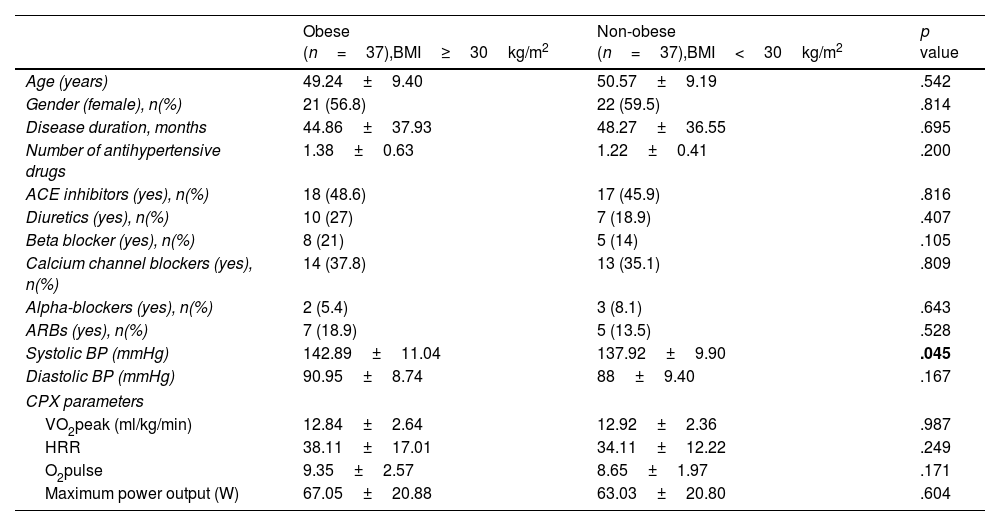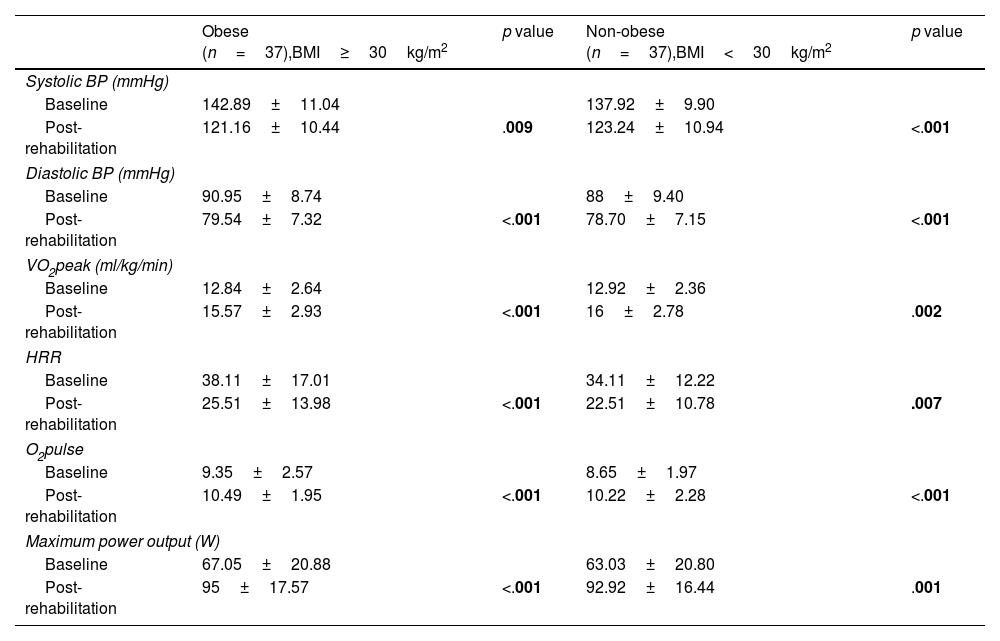The relationship between obesity and hypertension is clearly known and cardiac rehabilitation (CR) is shown as an effective treatment method in both obese and hypertensive patients. The aim of this study is to reveal the effect of CR on obese hypertensive patients by comparing them with non-obese hypertensive patients.
MethodsEighty eligible, volunteer participants with hypertension (SBP ≥140mmHg and/or DBP ≥90mmHg) were enrolled in this study. The patients were divided into 2 groups according to their BMI values: obese (BMI ≥30kg/m2) hypertensive patients and non-obese (BMI <30kg/m2) hypertensive patients. The CR program, in which aerobic exercise training was the main part, was performed on the patients. At the end of the 10-week CR program, the resting SBP and DBP values were measured.
ResultsA total of 74 patients (37 obese and 37 non-obese) completed the study. After CR significant improvements were achieved in all evaluated parameters compared to pre-CR values. When the amounts of changes before and after CR were compared, the decrease in SBP was found to be significantly higher in obese patients compared to non-obese patients (p=.003). Higher BMI was associated with more reduction in SBP (r=0.287, p=0.013).
ConclusionsExercise-based CR effectively reduced SBP in obese and non-obese hypertensive patients. However, it was more effective in obese patients compared to non-obese patients.
La relación entre obesidad e hipertensión es claramente conocida y la rehabilitación cardiaca (RC) se muestra como un método de tratamiento eficaz tanto en pacientes obesos como hipertensos. El objetivo de este estudio es revelar el efecto de la RC en pacientes hipertensos obesos comparándolos con pacientes hipertensos no obesos.
MétodosOchenta participantes voluntarios elegibles con hipertensión (PAS≥140mmHg y/o PAD≥90mmHg) se inscribieron en este estudio. Los pacientes se dividieron en 2 grupos según sus valores de IMC: pacientes hipertensos obesos (IMC≥30kg/m2) y pacientes hipertensos no obesos (IMC<30kg/m2). A los pacientes se les realizó el programa RC, en el que el entrenamiento con ejercicios aeróbicos fue la parte principal. Al final del programa RC de 10 semanas, se midieron los valores de PAS y PAD en reposo.
ResultadosUn total de 74 pacientes (37 obesos y 37 no obesos) completaron el estudio. Después de RC, se lograron mejoras significativas en todos los parámetros evaluados en comparación con los valores previos a RC. Cuando se comparó la cantidad de cambios antes y después de la RC, se encontró que la disminución de la PAS fue significativamente mayor en pacientes obesos en comparación con pacientes no obesos (p=0,003). Un IMC más alto se asoció con una mayor reducción de la PAS (r=0,287; p=0,013).
ConclusionesLa RC redujo efectivamente la PAS en pacientes hipertensos obesos y no obesos. Sin embargo, fue más efectivo en pacientes obesos en comparación con pacientes no obesos.










